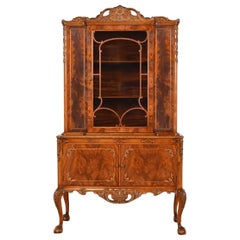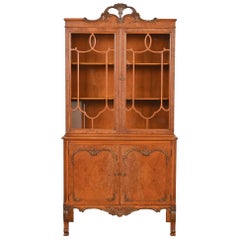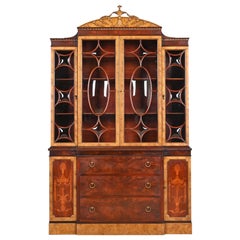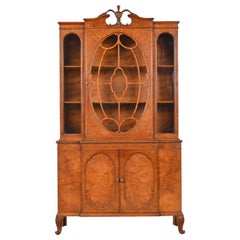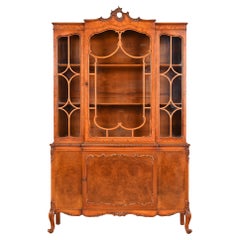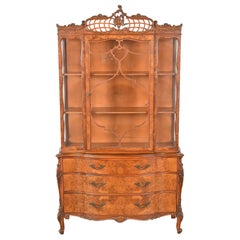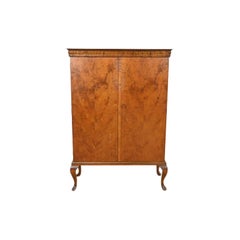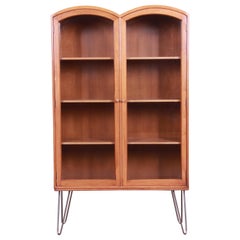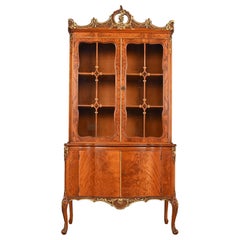Romweber Bookcase
Romweber Chippendale Flame Mahogany Breakfront Bookcase Cabinet, Circa 1920s
By Romweber Furniture Co.
Located in South Bend, IN
An exceptional Chippendale or Georgian style breakfront bookcase cabinet or dining cabinet
By
Category
Vintage 1920s American Georgian Bookcases
Materials
Brass
$3,995
H 71.13 in W 41 in D 18 in
Romweber French Provincial Louis XV Burl Wood Breakfront Bookcase Cabinet
By Romweber Furniture Co.
Located in South Bend, IN
An exceptional French Provincial Louis XV style breakfront bookcase cabinet or dining cabinet
By
Category
Vintage 1920s American Louis XV Bookcases
Materials
Brass
$3,595
H 76 in W 38 in D 16 in
Romweber French Regency Louis XVI Burled Walnut Breakfront Bookcase Cabinet
By Romweber Furniture Co.
Located in South Bend, IN
A gorgeous antique French Regency Louis XVI style breakfront bookcase cabinet or dining cabinet
By
Category
Vintage 1920s American Louis XVI Bookcases
Materials
Brass
$3,495
H 67.25 in W 41.25 in D 20 in
Romweber French Neoclassical Mahogany and Burl Wood Breakfront Bookcase Cabinet
By Romweber Furniture Co.
Located in South Bend, IN
An outstanding French Neoclassical or Louis XVI style bubble glass breakfront bookcase cabinet or
Category
Vintage 1930s American Neoclassical Bookcases
Materials
Brass
$4,995
H 82 in W 51.38 in D 14 in
Romweber French Provincial Louis XV Burl Wood Breakfront Bookcase Cabinet, 1920s
By Romweber Furniture Co.
Located in South Bend, IN
An exceptional French Provincial Louis XV style breakfront bookcase cabinet or dining cabinet
By
Category
Vintage 1920s American French Provincial Bookcases
Materials
Brass
$3,795
H 78 in W 44 in D 15.25 in
Romweber French Provincial Louis XV Burl Wood Breakfront Bookcase Cabinet, 1920s
By Romweber Furniture Co.
Located in South Bend, IN
An exceptional French Provincial Louis XV style breakfront bookcase cabinet or dining cabinet
By
Category
Vintage 1920s American Louis XV Bookcases
Materials
Brass
$3,795
H 79.25 in W 49 in D 15.25 in
Romweber French Provincial Louis XV Burl Wood Breakfront Bookcase Cabinet, 1940s
By Romweber Furniture Co.
Located in South Bend, IN
A gorgeous breakfront bookcase cabinet or dining cabinet
By Romweber
USA, Circa 1920s
Beautiful
Category
Vintage 1940s American French Provincial Cabinets
Materials
Brass
$3,795
H 78.5 in W 43.5 in D 16 in
Romweber Style Queen Anne Burl Wood Bookcase or Bar Cabinet, Circa 1930s
By Romweber Furniture Co.
Located in South Bend, IN
An exceptional Queen Anne style burl wood bookcase or bar cabinet
In the manner of Romweber
USA
Category
Vintage 1930s American Queen Anne Cabinets
Materials
Burl
$2,995
H 63.5 in W 44.5 in D 18.5 in
Recent Sales
Romweber Mid-Century Modern Walnut Glass Front Bookcase on Hairpin Legs
By Romweber Furniture Co.
Located in South Bend, IN
An exceptional Mid-Century Modern bookcase cabinet on hairpin legs
By Romweber
USA, circa
Category
Vintage 1950s American Mid-Century Modern Bookcases
Materials
Steel
Romweber French Provincial Louis XV Burl Wood Breakfront Bookcase Cabinet, 1920s
By Romweber Furniture Co.
Located in South Bend, IN
An exceptional French Provincial Louis XV style breakfront bookcase cabinet or dining cabinet
By
Category
Vintage 1920s American Louis XV Bookcases
Materials
Glass, Burl
H 79 in W 39.5 in D 17 in
Romweber Mid-Century Modern Walnut Glass Front Bookcases on Hairpin Legs, Pair
By Romweber Furniture Co.
Located in South Bend, IN
An exceptional pair of Mid-Century Modern bookcase cabinets on hairpin legs
By Romweber
USA
Category
Vintage 1950s American Mid-Century Modern Bookcases
Materials
Steel
H 60 in W 35.25 in L 60 in
Romweber Flame Mahogany Breakfront Display Cabinet or Bookcase, circa 1940s
By Romweber Furniture Co.
Located in South Bend, IN
A gorgeous inlaid flame mahogany breakfront china display cabinet or bookcase
By Romweber
USA
Category
Vintage 1940s American French Provincial Cabinets
Materials
Brass
H 76.5 in W 44.13 in L 76.5 in
Romweber Flame Mahogany Chippendale Curved Glass Cabinet or Bookcase, 1930s
By Romweber Furniture Co.
Located in South Bend, IN
An exceptional ornate carved flame mahogany Chippendale style dining bar cabinet or bookcase
By
Category
Vintage 1930s American Chippendale Cabinets
Materials
Glass, Mahogany
H 78 in W 40.5 in L 78 in
Romweber French Provincial Louis XV Rosewood Breakfront Bookcase Cabinet, Circa
By Romweber Furniture Co.
Located in South Bend, IN
An exceptional French Provincial Louis XV style breakfront bookcase cabinet or dining cabinet
By
Category
Vintage 1920s American Louis XV Cabinets
Materials
Brass
H 78.75 in W 44.5 in D 17 in
Romweber French Louis XV Burl Wood Breakfront Bookcase or Dining Cabinet
By Romweber Furniture Co.
Located in South Bend, IN
A gorgeous French Provincial Louis XV style two-piece breakfront bookcase or china cabinet
By
Category
Vintage 1950s American Louis XV Cabinets
Materials
Brass
Romweber French Provincial Louis XV Burl Wood Breakfront Bookcase Cabinet, 1920s
By Romweber Furniture Co.
Located in South Bend, IN
An exceptional French Provincial Louis XV style breakfront bookcase cabinet or dining cabinet
By
Category
Vintage 1920s American Louis XV Cabinets
Materials
Brass
H 78.5 in W 41 in D 16 in
Romweber French Rococo Burl Wood Dining Cabinet or Bookcase, Circa 1930s
By Romweber Furniture Co.
Located in South Bend, IN
A gorgeous French Rococo Louis XV style china cabinet or bookcase
By Romweber
USA, Circa
Category
Vintage 1930s American Rococo Cabinets
Materials
Glass, Burl, Paint
Romweber Mid-Century Modern Walnut Bookcase on Hairpin Legs, circa 1950s
By Romweber Furniture Co.
Located in South Bend, IN
A gorgeous Mid-Century Modern bookcase
By Romweber
USA, circa 1950s
Walnut, with steel
Category
Mid-20th Century American Mid-Century Modern Bookcases
Materials
Steel
H 59.88 in W 35.63 in D 14 in
Spectacular Midcentury Classical Romweber Walnut Bookcase Wall Unit
By Harold Schwartz, Romweber Furniture Co.
Located in Lafayette, IN
This spectacular wall unit by Romweber features an interesting mix of Classical and Mid-Century
Category
Vintage 1950s American American Classical Bookcases
Materials
Walnut
Pair of Spectacular Mid-Century Classical Romweber Walnut Bookcases Wall Units
By Harold Schwartz, Romweber Furniture Co.
Located in Lafayette, IN
These spectacular Wall units by Romweber feature an interesting mix of Classical and Mid-Century
Category
Vintage 1950s American American Classical Bookcases
Materials
Walnut
H 87.5 in W 180 in D 25.25 in
Romweber French Provincial Louis XV Burl Wood Breakfront Bookcase Cabinet, 1920s
By Romweber Furniture Co.
Located in South Bend, IN
An exceptional French Provincial Louis XV style breakfront bookcase cabinet or dining cabinet
By
Category
Vintage 1920s American Louis XV Cabinets
Materials
Brass
H 78 in W 46 in D 16 in
Harold M Schwartz bookshelf 50`s original published ROMWEBER
Located in 0, Cuauhtemoc
item was published and was made and sold by Romweber Furniture
Category
20th Century American Bookcases
People Also Browsed
Antique French Charles X Classical Secrétaire à Abattant Desk Chest Walnut 1825
Located in Portland, OR
A fine & elegant antique French Charles X figured walnut secretaire abattant, circa 1825.
A high quality French figured walnut secretary chest from the first quarter of the 1800s, th...
Category
Antique 1820s French Charles X Secretaires
Materials
Walnut
$2,995
H 60 in W 39.25 in D 17.5 in
English 1880s Black and Gold Breakfront Two Part Bookcase with Chinoiserie Décor
Located in Atlanta, GA
An English two part black and gold breakfront bookcase from the late 19th century with Chinoiserie décor, gilded Greek Key and floral décor, chicken wire doors, drawers and additiona...
Category
Antique Late 19th Century English Chinoiserie Bookcases
Materials
Wire
On Hold
$10,800
H 78 in W 57.5 in D 16 in
Art Deco and Art Nouveau Crystal Glass Fringe Hollywood Regency Gilt Table Lamps
Located in Coimbra, PT
Pair of French Art Deco, Art Nouveau green beaded etched glass straws table lamps.
Also have a matching chandelier
Measures:
Diameter 9 in/ 22 cm
Height 15 in/ 38 cm
Weight 6.6 ...
Category
Mid-20th Century French Hollywood Regency Table Lamps
Materials
Metal
$3,010 / set
H 14.97 in Dm 8.67 in
Art Deco and Art Nouveau Crystal Glass Fringe Hollywood Regency Gilt Chandelier
Located in Coimbra, PT
Fabulous midcentury Art Deco or Art Nouveau frosted and clear crystal glass fringe gilt spiral chandelier.
Measures:
Diameter 20 in/ 50 cm
Height 36 in/ 90 cm
Weight: 7 lb/ 6 Kg
Thre...
Category
Mid-20th Century French Hollywood Regency Chandeliers and Pendants
Materials
Crystal, Gold Plate, Metal
$4,515
H 36 in Dm 20 in
English Victorian 19th century portrait of a brown and white Spaniel dog
By George Earl
Located in Woodbury, CT
George Earl was a painter, primarily of sporting dogs and other animals. He was also the father of Maud Earl and Percy Earl, and the brother of Thomas Earl, all three of whom were al...
Category
1850s Victorian Animal Paintings
Materials
Oil, Canvas
$6,360 Sale Price
20% Off
H 25.5 in W 25.5 in
Mid-Century Rosewood and Glass Bookcase with Adjustable Shelves, 1960s
Located in Los Angeles, CA
Mid-Century open bookcase crafted from richly grained rosewood, likely produced in the 1960s. This minimalist storage piece features three height-adjustable glass shelves that rest w...
Category
Vintage 1960s Dutch Mid-Century Modern Bookcases
Materials
Glass, Rosewood
Antique Victorian Oversized Carved Walnut Armchair, C1890
Located in Big Flats, NY
An antique Victorian parlor chair offers oversized walnut frame with foliate carved crest, upholstered seta and back, and raised on cabriole legs, c1890
$1,500-$3,000
A stunning exa...
Category
Early 20th Century American Victorian Armchairs
Materials
Upholstery, Walnut
$1,160 Sale Price
20% Off
H 47 in W 25 in D 31 in
Amazing Pink Amethyst Murano Glass Leave Ceiling Light or Chandelier
Located in Rome, IT
Realized in pure pink amethyst color Murano glass consists of 45 delicious hand-blown leaves.
The structure is gilt-metal. Five E27 lights spread a magical light.
the price is item...
Category
1990s Italian Modern Chandeliers and Pendants
Materials
Glass
Grange French Regency Louis XVI Cherry Wood Bookcase or Display Cabinet
By Grange
Located in South Bend, IN
An exceptional French Regency Louis XVI style display cabinet or bookcase
By Grange
France, Circa Late 20th Century
Solid cherry wood, with brass hardware. Cabinet locks, and key ...
Category
Late 20th Century French Louis XVI Bookcases
Materials
Brass
$2,995
H 50.38 in W 29 in D 11.25 in
Pair Regency Open Bookcases in Walnut Open Front Bookcase
Located in Potters Bar, GB
Gorgeous pair of Regency Sheraton style open front bookcase in burl walnut
Tall and thin so elegant design to this piece
We can also split the pair up if you are looking for a single...
Category
Vintage 1980s Regency Bookcases
Materials
Walnut
Pair Mahogany Open Front Bookcase - Regency Sheraton Bookcase
Located in Potters Bar, GB
You are looking at a pair of English Sheraton style openfront bookcases hand crafted from the finest mahogany. This lovely pair are the perfect mix of decorative beauty and practical...
Category
Vintage 1980s Regency Bookcases
Materials
Mahogany
Amalfi, Italian Murano Glass Ceiling Light or Chandelier, 1970s
Located in Roma, IT
Splendid Murano glass ceiling lamp.
Period: circa 1970.
The ceiling light misure 35 cm in height, the diameter measures 75 centimeters.
It mounts 4 e27 lights, possible to rewire ...
Category
Vintage 1970s European Chandeliers and Pendants
Materials
Murano Glass
19th Century French Louis XVI Walnut Writing Table ~ Desk
Located in Dallas, TX
19th Century French Louis XVI Walnut Writing Table ~ Desk makes an attractive addition to any room, and can double as a center table as it is beautifully embellished from all angles!...
Category
Antique 1890s French Louis XVI Desks and Writing Tables
Materials
Walnut
Henredon Georgian Carved Mahogany Lighted Breakfront Bookcase Cabinet
By Henredon
Located in South Bend, IN
A gorgeous Georgian or Chippendale style lighted breakfront bookcase or dining cabinet
By Henredon, "18th century Portfolio" Collection
USA, circa 1980s
Carved banded mahogany, wi...
Category
Vintage 1980s American Georgian Cabinets
Materials
Brass
French Louis XVI Style Painted Chests / Commodes / Tables Att. To Julia Gray
By Julia Gray
Located in Kennesaw, GA
This is a pair of French Louis XVI style chests or side tables attributed to Julia Gray. They are green with gilt accents and have three drawers. They are in very good condition.
Category
Late 20th Century American Louis XVI Commodes and Chests of Drawers
Materials
Wood
$2,495 / set
H 27 in W 26.5 in D 17 in
Large 19th Century Victorian Breakfront Bookcase with Integral Secretaire
Located in London, GB
A very fine and large Victorian mahogany breakfront bookcase and secretaire. The upper part has four compartments, the doors of which are glazed with their original plate glass revea...
Category
Antique Mid-19th Century English Early Victorian Bookcases
Materials
Mahogany
$7,609
H 90.16 in W 79.14 in D 20.08 in
Get Updated with New Arrivals
Save "Romweber Bookcase", and we’ll notify you when there are new listings in this category.
More Ways To Browse
1930 Burl Wood China Cabinet
Romweber China Cabinet
Robot Cabinet
Spindle Bookcase
Suspended Bookcase
Theodore Alexander Althorp Collection
Theodore Alexander Castle Bromwich
Trumeau Bureau
Vintage Bookcase Uk
Vintage Yew Wood Book Case
Walnut Barrister
Wicker Shelving
William And Mary Bureau Bookcase
Willy Guhl Modular Cubes
Wrapped Rattan Etagere
4 Bay Cado Danish Modern Wall Unit
Amsterdam School Bookcase
Antique Desk Brighton
